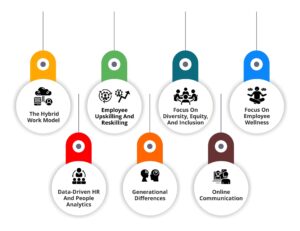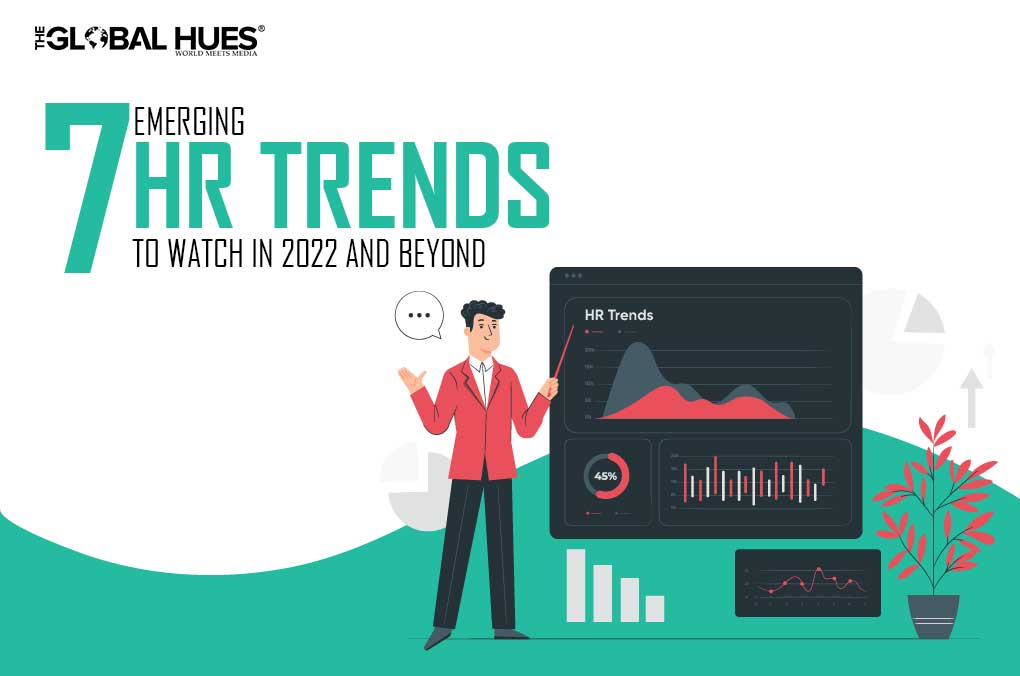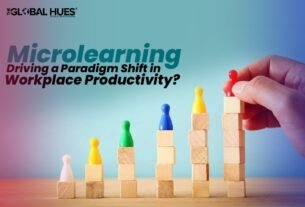Since the Covid 19 pandemic has hit the world, there has been a paradigm shift in where we work. The years 2021 and 2022 have changed the way we follow rules. Human Resources Industry has also witnessed several changes. 2021 reinvented HR and solidified its new role while 2022 is going to push the boundaries of how HR can add value.
Let’s take a look at the emerging HR trends that aim to help different businesses manage their workforce more productively and with greater efficiency in 2022 and beyond.

-
Trend No. 1: The Hybrid Work Model
Hybrid Work Model is a location flexible arrangement, in which employees are allowed to combine onsite and offsite work as they and their employees see fit. The pandemic has forced companies to adopt a hybrid work model where employees can continue to work remotely as well as from the office.
A survey conducted by WeWork and Workplace Intelligence found that “64% of the employees would pay for access to an office space and 75% would give up at least one benefit or perk for the freedom to choose their work environment.” The report also mentions that 79% of the C-Suite plans to encourage employees to split their time between corporate offices and remote working if their job permits it.
The hybrid work model, instead of focusing on the place of work, encourages the delivery of better business results while also ensuring employees’ wellness. Companies are massively thinking about this transformation in the coming years.
-
Trend No. 2: Employee Upskilling and Reskilling
Businesses are now focusing on upskilling and reskilling their existing workforces. In the long run, upskilling and reskilling programs can improve employee engagement and retention, increase collaboration & mutual understanding between different departments, attract new talent, and speed up the adoption of new trends within the company. To approach the upskilling of employees, companies are implementing performance enablement technologies that allow companies to build a resilient workforce by connecting performance data to the personalized learning experience.
-
Trend No. 3: Focus on Diversity, Equity, and Inclusion
Diversity, Equity, and Inclusion (DEI) play a pivotal role in creating and maintaining a successful workplace; one founded on the principle that all employees can thrive personally and professionally. Companies with a diverse and inclusive workforce perform better, generate higher revenue, and understand the demands of newer markets.
Various studies show that work-related stress affects minorities in particular due to different levels of education attained, and poor treatment by management. A good DE&I program helps sensitize both employees and the management. It would also lead to a boost in employee productivity as it would encourage the minority communities to feel more comfortable in their environment and more accepted and included.
-
Trend No. 4: Focus on Employee Wellness
As per the Gartner Survey of more than 20,000 employees between January 2020 and March 2021, Covid has negatively impacted the health of 55% of the global workforce. The report revealed that all segments of the workforce experienced significant damage, specifically:
- At least 50% of the workforce at each level
- At least 44% of the workforce in each function
- At least 35% of the workforce in each industry
Employers in 2022 and beyond will be more proactive than ever to make employee wellness and health a priority. Employers’ investment in employee wellness programs can lower healthcare costs and insurance claims.
-
Trend No. 5: Data-Driven HR and People Analytics
People analytics is a deeply data-driven and goal-focused method of studying all people processes, challenges, opportunities, and functions at work to evaluate the effectiveness of human resources initiatives. The key drivers to people analytics are:
- The use of technologies like AI-powered chatbots, recruitment automation tools, and screening tools to make a candidate’s experience more engaging.
- The rise of the Chief Human Resources Officer (CHRO) in the organization’s processes. HR executives need to adopt a data-driven mindset to analyze the current and future workforce demand, and skill gaps, among others.
-
Trend No. 6: Generational Differences
Four generations (Boomers, Generation X, Millennials, and Gen Z), for the first time in history, are in the workforce at the same time. The Boomers are retiring, Gen Xers are the smallest group and are often ignored. Therefore, the ones enjoying the power are Millennials and Gen Zers. In Deloitte’s 2020 Global Human Capital Trends report, more than half of the respondents revealed that they consider generational differences when designing and delivering workforce programs. But only 6% believed that their managers are equipped to lead a multigenerational workforce efficiently. Despite everything, HR leaders are going to work hard to unite all these groups because these generational gaps will continue in 2022 and beyond.
-
Trend No. 7: Online Communication
Communication is used in human resources to relay information from directors to employees. This information can be related to company policies, goals, or other important aspects. Remote work is not going anywhere, it is here to stay. Companies will have to invest in top-notch HR technology that would allow video interviews, meetings, and continuous virtual communications.
To conclude, we can say that the last couple of years has brought diverse changes in the Human Resouces industry. Going forward, HR can play a crucial role in building the organizations of the future.




